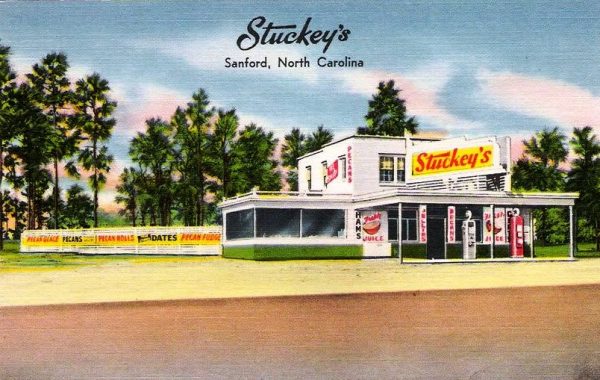 In the heyday of road trips – roughly from the 1950 to the early 1970s – many of you probably remember somebody asking you to send them a postcard to let them know how you were doing while you were out gallivanting all around the country. Back then, postcards were about as ubiquitous as the places they promoted on the front. Nearly every motel, hotel, restaurant, gas station, and roadside attraction had a postcard. Heck, you could even go into any Stuckey’s in America and find a picture postcard of the very Stuckey’s location you were standing in. Write a quick note on the back letting the folks back home know that you all were doing okay on your little family road trip and Stuckey’s would even mail it off for you. Unfortunately, with the advent of the internet and email in the 1990s, the postcard has given way to text messaging and selfies on social media; as a result, postcards are usually only bought as souvenirs today. Before the postcard becomes history, however, the history of the postcards is today’s subject on the Stuckey’s Pecan Blog Roll.
In the heyday of road trips – roughly from the 1950 to the early 1970s – many of you probably remember somebody asking you to send them a postcard to let them know how you were doing while you were out gallivanting all around the country. Back then, postcards were about as ubiquitous as the places they promoted on the front. Nearly every motel, hotel, restaurant, gas station, and roadside attraction had a postcard. Heck, you could even go into any Stuckey’s in America and find a picture postcard of the very Stuckey’s location you were standing in. Write a quick note on the back letting the folks back home know that you all were doing okay on your little family road trip and Stuckey’s would even mail it off for you. Unfortunately, with the advent of the internet and email in the 1990s, the postcard has given way to text messaging and selfies on social media; as a result, postcards are usually only bought as souvenirs today. Before the postcard becomes history, however, the history of the postcards is today’s subject on the Stuckey’s Pecan Blog Roll.
Before Congress passed a law on February 27, 1861, allowing Americans to mail blank or printed postcards, people would send cards through the mail with pre-paid postage known as “mailed cards”. At the same time, people also sent envelopes with pictures printed on them which some say could be the ancestor of the postcard. However, taking advantage of this new law, a Philadelphia printer and stationer by the name of John P. Charlton copyrighted the first postcard in 1861. Sometime later, Charlton would sell his copyright to fellow Philadelphia stationer Hymen L. Lipman. The earliest of the known Lipman Postal Cards being postmarked on October 25, 1870, and required the same amount of postage as a regular letter. Lipman later applied for a patent for his postcard, but because other stationers around the country were also printing and selling postcards, Lipman’s patent application rejected. Moreover, the cards at this time were not really interesting as they usually just had the name of the printer on the front where you also wrote the address and applied the stamp; the back was blank and where you would write your message.
In 1873, the government got in on the postcard action when it produced its first postcard on May 1 with one side being for the message and the other side being for the addressee with the tern. To keep things competitive, the postcards the government printed only cost 1¢ to mail while the private publishers would cost you 2¢. This trend of the somewhat boring postcard with just two blank sides save the words “Postal Card” on the government versions continued until 1898 when the government finally relented to the private postal card makers and let them print the statement “Private Mailing Card, Authorized by Act of Congress of May 19, 1898” on them and reduced their price so that now both costs only 1¢ to mail.
It wouldn’t be until the turn of the century in 1901 when the Post Office allowed the 1898 Postal to be replaced by the words “Post Card” on private post cards. It was also at this time that the first picture postcards were made; but because the USPS wouldn’t allow any messages on the address side, just the pictures were sent. However, the postcard was in for some big changes in the years to come.
In 1907, the Universal Postal Union’s legislative body, the universal postal Congress, allowed post cards produced by member governments could leave room for messages on the left of the postcard’s address side. Subsequently, congress also passed an act that same year allowing privately made postcards to do the same. As a result, the “Divided Back Period” was born, ushering in the “Golden Age of Postcards”.
Another change would take place in 1915 when the “White Border Period” started – a name that came from the fact that a white border began showing up on postcards that were now using real photographs. Most of these photos were taken with the Kodak “postcard camera” which, as you may have guessed, created postcard negatives that also happen to come with a divided pack an area marked for postage. Also, note how postcards from the White Border Period have a description of the photo on the message side of the divided back – a trend that continues until today.
1931 saw the beginning of what would become known as the linen postcard period when printers used new ways of printing that allowed them to put higher rag content into their postcards which gave the postcards a look like they were printed on linen rather than paper. Chicago postcard publisher Curt Teich & Co. would be the first to you this new process and as a result, the company became famous all over the world for its linen postcards. The technique used by Curt Teich & Co. allowed for faster production and more colorful postcards as brighter dyes could be used in the process as well.
Some things remained the same on these new linen postcards, however, such as the divided backs and white borders. Nevertheless, by the end of the decade an even newer, and familiar, postcard era would emerge – the Photchrom Period.
Photochrom (or “photochrome”) postcards are cards that look like an actual photo on the front. The cards still have their divided backs, but the white borders disappeared with the photo going all the way to the edges. The Union Oil Company would be the first to use the photochrom-style to promote their service stations out west. Like most things in World War II, the rationing of supplies slowed production; however, once the war was over and returning servicemen and women started buying cars and taking family road trips, photochroms were at the top of the postcard market once again. That trend continued all the way up until the advent of email and social media in the 1990s and 2000s.
You can still walk into any Stuckey’s store today and find a postcard. And at 35c, mailing it to somebody and making their day a little bit more special is still a pretty good deal.
While your there checking out postcards, don’t forget to grab some of our fine pecan candies from Stuckey’s for the folks back home. After all, who wouldn’t love a couple of our Stuckey’s pecan log rolls or a box of pecan divinity or pecan pralines to munch on?.
Not sure what to get them? Then check out our gift bundles which have a little something in them for everybody including t-shirts, caps, our melt-in-your-mouth pecan candy and other Stuckey’s memorabilia that everybody loves!
 With Easter around the corner, what kid (or kid at heart) wouldn’t want the Easter Bunny to bring them the Stuckey’s “Kids Fun” Easter Basket? It’s packed fully of delicious treats and other fun things including:
With Easter around the corner, what kid (or kid at heart) wouldn’t want the Easter Bunny to bring them the Stuckey’s “Kids Fun” Easter Basket? It’s packed fully of delicious treats and other fun things including:
1 – 2 oz. Pecan Log Roll
1 – Wooden train Whistle
1 – Magic Ink Fun Book
1 – Bag of Jelly Beans
1 – Bag of Lemon Drops
1 – Flavored Popcorn
1 – Stuckey’s Gift Tin
And don’t worry if there’s no Stuckey’s location near you. You can always order from our webpage and have it sent directly to your home and maybe the Easter Bunny will be the one delivering it right to your front door.
Visit stuckeys.com to get more info!
Stuckey’s – We’re Making Road Trips Fun Again!
Whether your next road trip is by car or by rail, it’s not really a road trip without taking Stuckey’s along. From our world famous Stuckey’s Pecan Log Rolls to our mouthwatering Hunkey Dorey, Stuckey’s has all the road trips snacks you’ll need to get you where you’re going.
For all of the pecany good treats and cool merch you’ll need for your next big road adventure, browse our online store now!
Stuckey’s – We’re Making Road Trips Fun Again!
